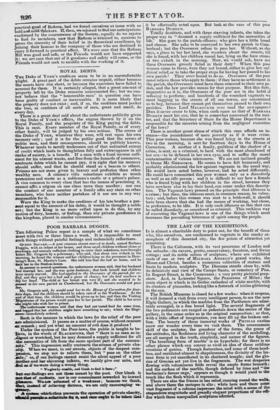THE LAST OF THE EXHIBITIONS.
IT is almost a charitable duty to point out, for the benefit of those who, like ourselves, are condemned to vegetate in the smoky at- mosphere of this deserted city, the few points of attraction yet remaining.
There is the Coliseum, with its vast panorama of London and the suburbs—its cavern, grotto, conservatory, fountain, and Swiss cottage' and its noble saloon of sculpture, where are exhibited casts of one or two of MICHAEL ANGELO'S grand works, the Moses and Christ, besides a numerous collection of statues and busts by modern sculptors. The Diorama stands close by, with its delusively real view of the Campo Santo, or cemetery of Pisa. In Regent Street, is the cosmorama ; a very pretty pictorial peep- show. And, in Leicester Square, the Panorama of Milan; the main object in which is its Gothic cathedral of white marble, with its clusters of pinnacles, looking like a fretwork of icicles glittering in the sun.
The British Museum is closed for a few weeks-: when it reopens, it will demand a visit from every intelligent person, to see the new Elgin Gallery, in which the marbles from the Parthenon are admi- rably arranged, in a fine broad light. The several fragments of the two pediments are ranged on pedestals down the centre of the gallery, in the same order as in the original composition; so that, with a little effort of imagination, you may fill up the broken out- line. The beauty of these immortal works of PHIDIAS excites anew our wonder every time we visit them. The consummate skill of the sculptor, the grandeur of the forms, the grace of the attitudes, the fleshiness and living character of the modelling, are all merged in the truth, simplicity, and nature of the figures. "The breathing form of marble is no hyperbole • for there is no other phrase which can convey so vivid an idea of these sublime creations of genius. Though featureless, and some of them head- less, and mutilated almost to shapelessness, the divinity of the hu- man form is yet manifested in its shattered temple; and the gla- ries of Grecian art yet live in the fragments. The wet draperies flowing with voluminous folds reveal the ample forms beneath.; and the surface of the marble, though defaced by time and "the barbarian's fiercer rage," appears as though it would yield to the touch like the flesh which it represents. There are also the friezes in bas relief, running round the walls, and above them the metopes in alto ; while here and there some vast fragment of a column impresses the mind with a sense of the stupendous magnitude and grandly elegant proportions of the eth- Ice which these unequalled sculptures adorned. The Etruscan Museum at the Egyptian Hall in Piccadilly con- tails an infinite number of antique curiosities, Which have been recently exhumed from the tombs of the Kings of Etruria, on the estate of Luc IEN BCONA.PARTE—the site of the ancient Vitulonia. They consist of a number of fictile vases and pateras ; a numerous collection of articles in copper and bronze, consisting of mirrors, tripods domestic and sacrificial vessels and utensils, handles, &c., , in all of which is observable an elegant taste in form and orna- ment. One tripod consists of three human legs united under a kirtle, from which rises the stem; the feet are shod with socks. On another, is a fox climbing up after a cock. Some of the handles of the covers of vessels are formed of a little figure of a man bent backwards and resting on his hands and feet ; and there are many specimens of similar ingenuities. A helmet of classical shape without crest or beaver—another of a flat conical form, like the old steel cap at one time common in the French and English armies—and a pair of greaves, of elastic metal, clasping round the calf of the leg—are almost the only remains of warlike cha- racter. A very superb display of gold ornaments, consisting of necklaces, bracelets, ear-rings, pins, little bottles (like vinaigrettes), supposed to have contained poison, but more likely scents, display the splendour of the Etruscan ladies. The ornaments are not dis- similar to many worn in the present day ; but they are of beaten gold, very light and thin, and lined with ebony and mother of pearl, to give them solidity. There are also a few fine pictures exhibited ; of which, a very expressive portrait of Machiavelli, and one of Cardinal Bembo, are most interesting. These two portraits are of the highest class of art. The Papyro-Museum, in Old Bond Street—a collection of inge- nious little models in paper, of figures in groups, formin.?t, charac- teristic scenes in town and country life—is also deserving of a visit. The whole are the work of two ladies, who devote the pro- ceeds of the exhibition and sale to a charitable purpose. We have before spoken of this unique exhibition at greater length.



























 Previous page
Previous page